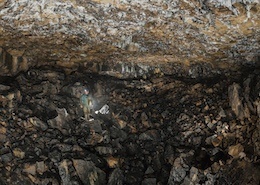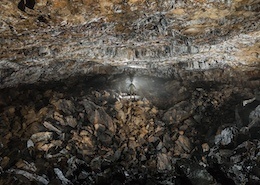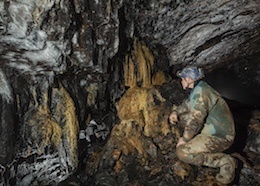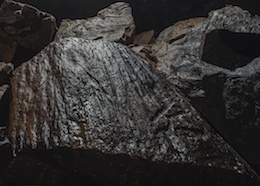Overview
This cave is fine example of a sub caprock shakehole, forming a single chamber connected to the outside by a small passage. The cave sits above Siambr Ddu Passage of Ogof Draenen which this cave is related to.Length 46m
Altitude 396m
Grid SO 25074 11516
History
The site was first identified on a visit by Percy Playford of the Cwmbran Caving Club in April 1967, then on Wednesday evening, the 11th of October 1967, Percy Playford, Michael Austwich, Russell Pope, Dave Lloyd and Dennis Bennett returned to the site. They dug at the bottom of a depression beside the tram road at the top of the quarry. After a short while rocks pulled out reveled a rift heading down steeply and after a couple of hours Russel Pope was able to squeeze through into low passage leading to a chamber beyond.
Location
The cave is located above Pwll Du quarry on the opposite side of the road to Pen Ffordd Goch pond. From the road near the pond a public footpath heads down to the quarry, follow this around the top bench of the quarry to the western side where the entrance is located just before a stone wall is reached. Clydach Gorge Google map showing the location of Siambr Ddu and other caves in the area.
Location map - click marker to show entrance photo
Description
The entrance is located in a depression beside the track, which in summer is filled with verdant ferns. In the early part of winter the cave is a roost for Lesser Horseshoe bats and is best avoided. The entrance leads down a slope to a low crawl on the right and then a low squeeze before a sharp right hand turn leads into the vast chamber. The floor of the chamber is littered with boulders forming a depression in the centre. Most of the rocks are covered in a soft, black peaty deposit making the chamber feel quite oppressive and give the cave its name the Black Chamber - Siambr Ddu. Around the rim of the crater in the centre of the chamber are several alcoves some of which are adorned with bright yellow, orange and black formations. The generally flat ceiling has some small stalactites covering it particularly on the far side. A notable feature of this cave is the array of fossilised tree trunks including varieties of Lepidodendron that can be seen in the rock and in the ceiling of the chamber.
Tackle
No tackle is required.
References
Cambrian Cave Registry for Siambr Ddu Wicipedia Entry | (Welsh Language)
Cave life | Notes on Lesser Horseshoe bats
Sinkholes and Subsidence Karst and Cavernous Rocks in Engineering and Construction | Tony Waltham, Fred G. Bell, Martin Culshaw | Chapter 3 p74-75
Caves of South Wales | Tim Stratford | ISBN: 1-871890-03-9 | Published by Cordee
The Caves of Clydach | Tony Oldham
Cwmbran Caving Club | Journal No.1 p12-14 including survey
A Caver’s View of the Clydach River | Theo Schuurmans | p140-141 including survey
Swansea Geographer | No.15 p53-55
Wessex Caving Club | Journal No.172 p41-46 including survey
Warnings
The whole cave is formed in collapsed gritstone caprock. These large boulders are unstable in many areas and covered in slippy deposits - great care should be taken.
Disclaimer
The photographs and information of this page has been provided to help cavers planning trips. Caving can be a dangerous activity, if you are interested in exploring caves please join a caving club so you can enjoy a safe introduction to this sport. Local caving clubs are listed on the links page or you can visit the 'New To Caving' website for more options.If you feel that any of the information is incorrect or should be updated please contact us.








